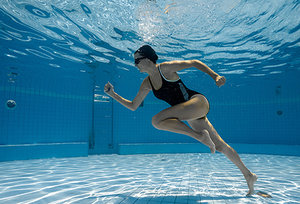Time to HIIT the Water
By Editorial Staff
That's not a typo: HIIT – high-intensity interval training – "incorporates several rounds that alternate between several minutes of high intensity movements to significantly increase the heart rate to at least 80% of one's maximum heart rate, followed by short periods of lower intensity movements," according to the Harvard T.H. Chan School of Public Health. Research suggests HIIT increases exercise capacity (the maximum amount of exercise someone can sustain), among other benefits.
But what if you can't do high-intensity interval movements – at least not on land? Try HIIT in the water – a new review study says it's just as effective as land-based HIIT.
 Researchers analyzed 18 trials involving approximately 900 participants who performed water-based HIIT. Participants had been diagnosed with a range of medical conditions that could make land-based workouts challenging (type 2 diabetes, osteoarthritis, heart conditions, etc.). Compared with not exercising at all, performing HIIT improved exercise capacity to approximately the same extent whether done in the water or on land. Findings appear in BMJ Open Sport & Exercise Medicine.
Researchers analyzed 18 trials involving approximately 900 participants who performed water-based HIIT. Participants had been diagnosed with a range of medical conditions that could make land-based workouts challenging (type 2 diabetes, osteoarthritis, heart conditions, etc.). Compared with not exercising at all, performing HIIT improved exercise capacity to approximately the same extent whether done in the water or on land. Findings appear in BMJ Open Sport & Exercise Medicine.
The importance of these findings can't be emphasized enough, especially with an aging, too-often health compromised population that desperately needs physical activity for health and wellness, but can't always do it because of limitations. As the authors make clear, water-based HIIT may be a great alternative to land-based HIIT.

